Omo Valley: The Extraordinary Tribal People of southern Ethiopia: Photography Tour Report 2023
29 March 2023




























































































































An injured Suri warrior during a stick fight (image by Inger Vandyke)

A beautiful Suri girl with her decoration of seed pods and flowers (image by Inger Vandyke)

The hand painted walls of a Maji tukul house. These beautiful murals are usually created by local women (image by Inger Vandyke)

Portrait of a stunning young Arbore girl (image by Inger Vandyke)

A young Karo child inside his home, surrounded by his family members who kindly invited us in for tea (image by Inger Vandyke)
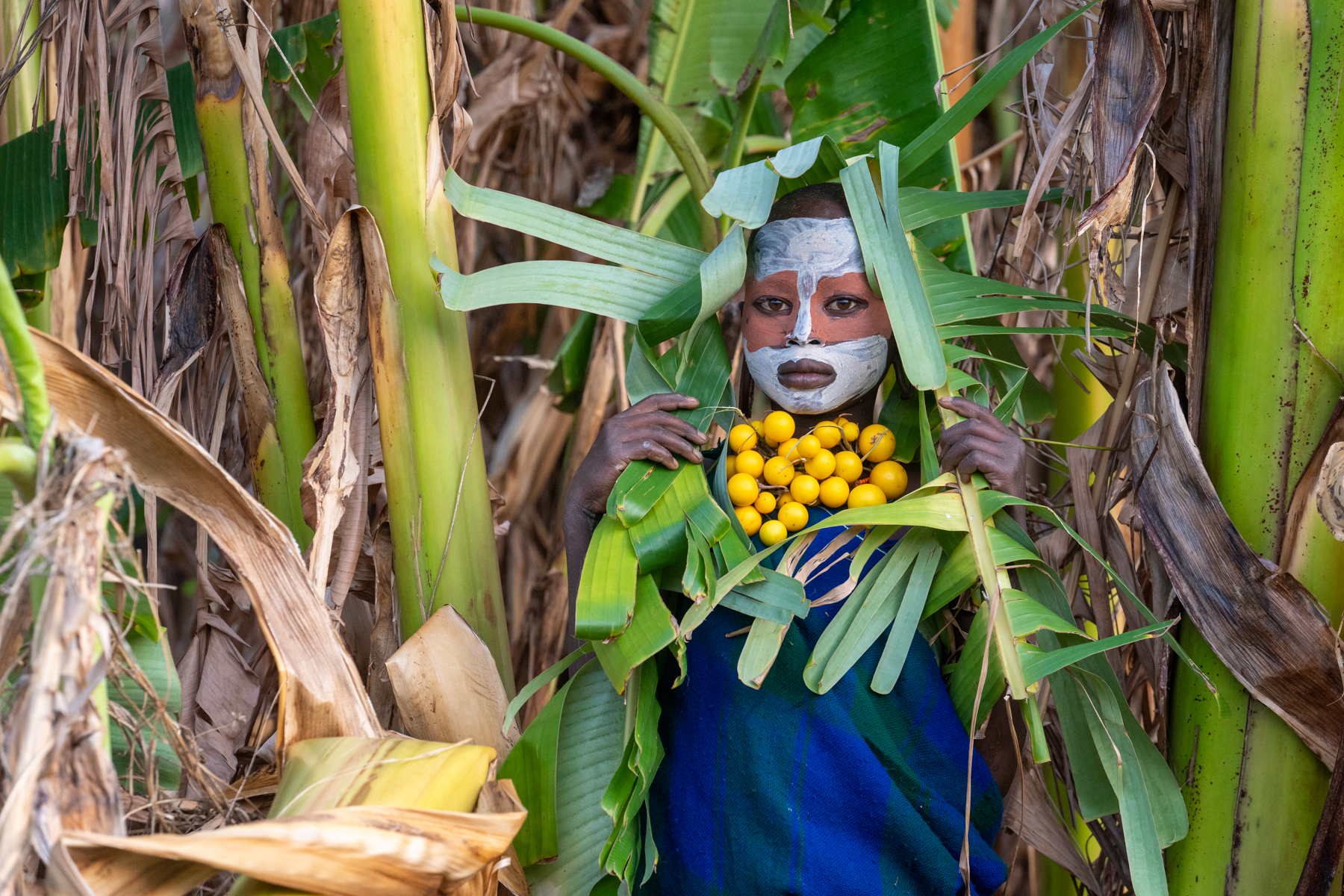
Suri people take inspiration from everything around them when they decorate their bodies (image by Inger Vandyke)

At the end of her scarification, a young Suri girl is supported by her friend and smiles with relief that its over (image by Inger Vandyke)

A group of young Benna boys showing off their strength and stilt walking prowess (image by Inger Vandyke)

The large disc earrings of Suri girls are truly stunning (image by Inger Vandyke)

Arbore women are so incredibly beautiful (image by Inger Vandyke)

The pretty disc necklaces worn by Nyangatom women (image by Inger Vandyke)

A Karo family herding their goats and sheep at sunrise near the Omo River (image by Inger Vandyke)

A shy young Karo girl watches us from the log she chose to sit on in her village (image by Inger Vandyke)

Hamer women near the local market in Turmi (image by Inger Vandyke)

Portrait of a Maji woman in the doorway of her home (image by Inger Vandyke)

Karo girls painting their signature Guineafowl patterns (image by Inger Vandyke)

A Dassanech nomad woman braves a sudden sand storm to greet us on the side of the road (image by Inger Vandyke)

Portrait of a young Arbore woman (image by Inger Vandyke)

The wild and mesmerising beauty of Mursi women (image by Inger Vandyke)

Dassanech women and child walking towards Omorate in a dust storm (image by Inger Vandyke)

Portrait of a young Mursi girl (image by Inger Vandyke)

A Nyangatom woman breaks into a spontaneous dance during our visit. It was so beautiful! (image by Inger Vandyke)

Arbore wedding decoration is mesmerising (image by Inger Vandyke)

Hamer people store wood in the upper branches of a gigantic Desert Rose euphorbia, to protect it from being eaten by termites (image by Inger Vandyke)
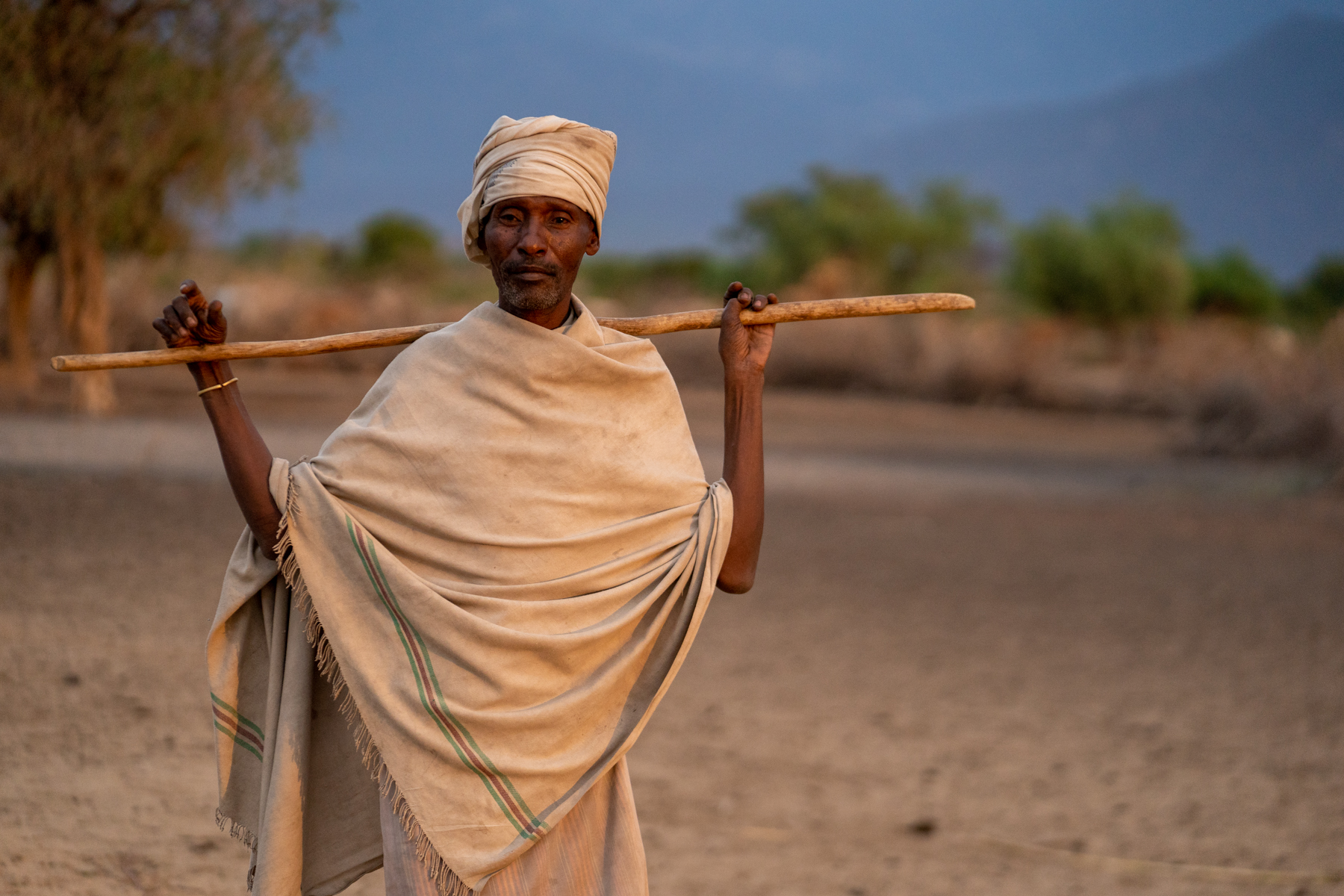
An Arbore elder returns from herding livestock at sunrise (image by Inger Vandyke)

Suri in Sepia (image by Inger Vandyke)

Many traditional people in Africa carry a wooden stool which they sometimes use as a head rest to sleep (image by Inger Vandyke)

A stunningly decorated Nyangatom woman stands in the equally stunning homes of her village (image by Inger Vandyke)

Gamo fisherman paddling his raft out on Lake Chamo (image by Inger Vandyke)

A stunning Hamer woman giggling during our visit to her village (image by Inger Vandyke)

Decorated Dassanech men at Dimi (image by Inger Vandyke)

An elder renders an injured Donga stick fighter assistance in the field (image by Inger Vandyke)

The eye of a Nile Crocodile in Lake Chamo (image by Inger Vandyke)

A young Suri girl with her decoration of berries in the early morning sun (image by Inger Vandyke)

Portrait of a Karo elder in the marmar, or meeting house of Karo headmen (image by Inger Vandyke)

A Dassanech elder returns from herding his livestock (image by Inger Vandyke)

Suri woman with her lip disc and tiny puppy (image by Inger Vandyke)

Portrait of a smiling Dassanech girl in the door of her home (image by Inger Vandyke)

Gigantic Nile Crocodiles call Lake Chamo home (image by Inger Vandyke)

The Arbore people of Lake Chew Bahir wake up to a beautiful sunrise on our tour (image by Inger Vandyke)

Young Hamer best friends smiling and exchanging laughs during our visit to their village (image by Inger Vandyke)

A backlit Karo head man returns from herding his livestock (image by Inger Vandyke)

Karo children tussle over who gets to pet their baby goat (image by Inger Vandyke)

A young Suri boy with his breakfast of fresh cow's blood. This is an important source of protein for young Suri people (image by Inger Vandyke)

Suri warriors fighting Donga, or a stick fight, designed to settle local disputes between rival clans (image by Inger Vandyke)

A stunning Suri woman with her lip disc in our sunrise photo shoot (image by Inger Vandyke)

The breathtaking beauty of Lake Chamo at sunrise (image by Inger Vandyke)
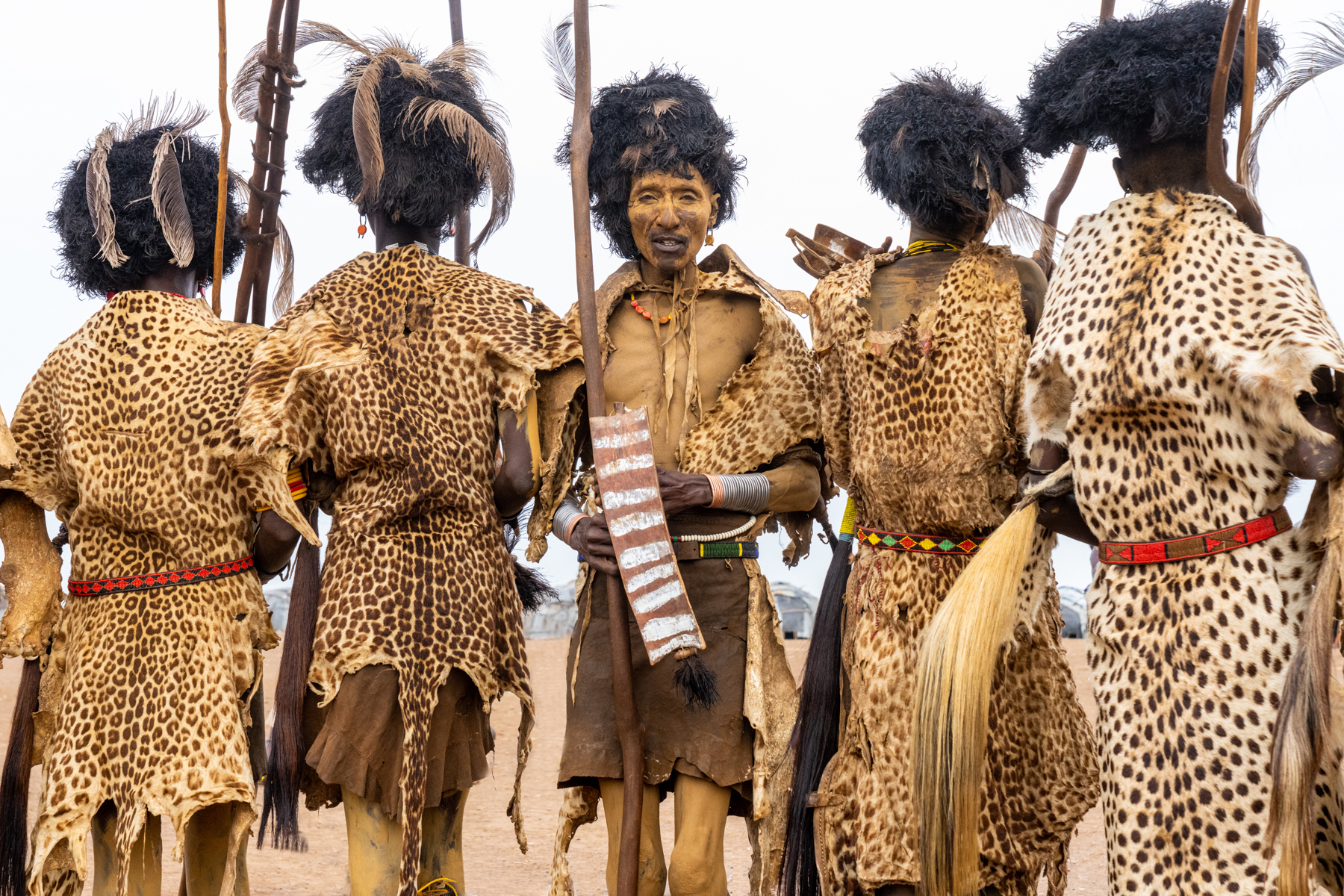
Decorated Dassanech men covered in skins and yellow ochre to celebrate Dimi, the Dassanech initiation ceremony of young girls (image by Inger Vandyke)

A young Suri man prepares to enter the arena of a Donga stick fight (image by Inger Vandyke)

An elderly Christian priest holding his wooden crucifix outside the Cathedral of St George in Addis Ababa (image by Inger Vandyke)

A young Mursi child stays warm at sunrise (image by Inger Vandyke)

A female friend covers the eyes of her girlfriend undergoing scarification in Suri culture (image by Inger Vandyke)

Mist hangs in the valleys of the Maji area at sunrise on the first day of our tour (image by Inger Vandyke)
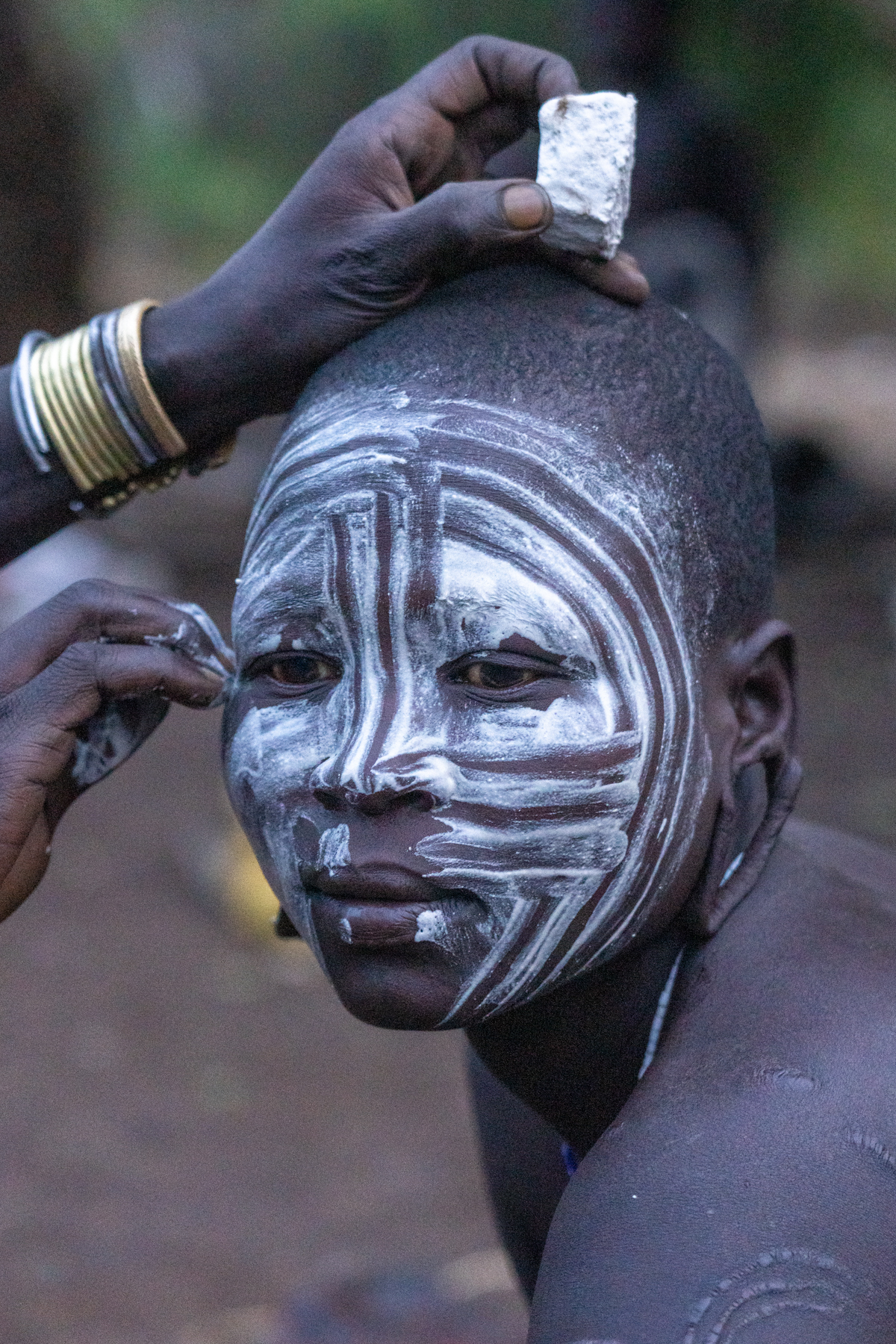
A friend runs her fingers through the chalk paint on a Mursi woman's face, to create decorative lines (image by Inger Vandyke)

Profile of an amazing Hamer woman we met on a remote section of our tour (image by Inger Vandyke)

Spectacular decoration of Ethiopia's Mursi people (image by Inger Vandyke)

Created by women, the granaries of Nyangatom villages are some of the finest examples of African vernacular architecture we see on our trip (image by Inger Vandyke)

Bling is bling - a Hamer man we met wandering with his necklace fashioned out of bullets (image by Inger Vandyke)

Portrait of a Karo woman with her little boy in Dus (image by Inger Vandyke)

An ethereally beautiful Suri girl with her headdress of fresh poinciana flowers (image by Inger Vandyke)

The delicated dot painting of Mursi people (image by Inger Vandyke)

Young Arbore man with his face decorated in preparation for an Arbore wedding (image by Inger Vandyke)

Portrait of a young Arbore girl with her goat kid (image by Inger Vandyke)

Large flat stones are laid out as a waiting area for guests visiting the elders of a Konso village (image by Inger Vandyke)

Portrait of a proud Nyangatom woman with her goat kid (image by Inger Vandyke)

A group of Suri men paint their bodies before they go into battle (image by Inger Vandyke)

Portrait of a Karo elder herding his livestock in the dust of sunrise (image by Inger Vandyke)

A group of Karo head men at the edge of the Omo River (image by Inger Vandyke)

A contemplative young Arbore girl in her village at dusk (image by Inger Vandyke)

A young boy painted to become a Suri warrior (image by Inger Vandyke)

A young Mursi girl with face paint (image by Inger Vandyke)

Looking like a jewel in a handmade wall of wood, a Hamer woman sits in the doorway of her temporary agricultural home (image by Inger Vandyke)

Young Suri boys splashing and playing in the Kibish River (image by Inger Vandyke)

Close up of the scarification practice in Suri people (image by Inger Vandyke)

Portrait of a young Dassanech man prepared to attend Dimi (image by Inger Vandyke)

We all have to start somewhere! A father helps his Benna son to learn how to walk on stilts (image by Inger Vandyke)

After Hamer men have completed a successful hunt they decorate their hair with feathers and red ochre (image by Inger Vandyke)
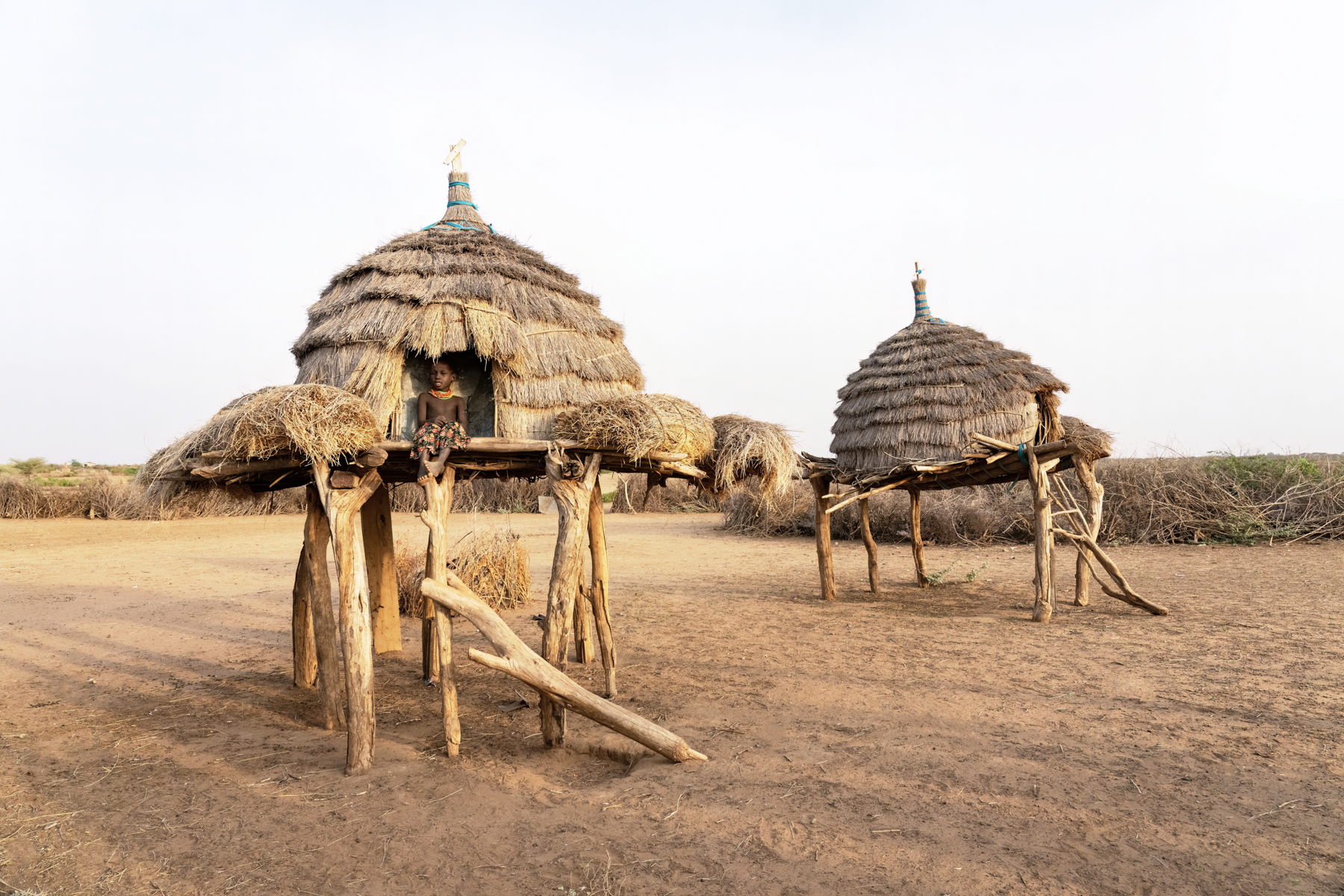
A young Nyangatom girl sitting in the hand sculpted granaries of her village (image by Inger Vandyke)

Sunrise and a young Nyangatom man stands with his tooth brush fashioned out of green sapling branches (image by Inger Vandyke)

A young Nyangatom man in the remote Ilemi Triange of Ethiopia (image by Inger Vandyke)

Benna in Blue (image by Inger Vandyke)

Portrait of an elderly Hamer Besheda woman with her goat skin dress and decorated kalabash headdress (image by Inger Vandyke)

A young girl stands with Dassanech elders ahead of her initiation (image by Inger Vandyke)

The stunning beauty of Nyangatom decoration includes brass and copper bracelets, handmade beaded belts and skirts (image by Inger Vandyke)

Portrait of a Dassanech elder (image by Inger Vandyke)

Young Hamer kids take advantage of the flash flood to have a swim (image by Inger Vandyke)

A visiting Toposa man sits in the door of his home in the remote Ilemi Triangle (image by Inger Vandyke)

Profile of a prominent Benna head man wearing a carabiner as an earring (image by Inger Vandyke)

A beautiful Arbore woman resting against a dead tree trunk (image by Inger Vandyke)

A young Arbore girl carries a goat kid back to her village (image by Inger Vandyke)

A young Arbore man paints his face to prepare for a wedding ceremony (image by Inger Vandyke)

A group of young Arbore women covered by their signature black cloth (image by Inger Vandyke)

Mysterious Waka, or Konso totem poles, are erected at the grave sites of Konso elders (image by Inger Vandyke)

Young Benna boys walk over me on their wooden stilts (image by Inger Vandyke)

Soulful silhouette of a Hamer head man inside his home (image by Inger Vandyke)

Dassanech men preparing yellow ochre to paint their bodies with in preparation for Dimi (image by Inger Vandyke)

Lip discs for sale in a remote Mursi village (image by Inger Vandyke)

A smiling Karo woman has her hair done in an open-air salon. Karo women fashion their 'bobble' hair using ochre and animal fats (image by Inger Vandyke)

A hand sculpted Mursi lip plate (image by Inger Vandyke)

Portrait of a young Suri herder at sunrise in his cattle camp (image by Inger Vandyke)

An elderly Hamer woman with her amusing dried flower, outside a local shop in Turmi (image by Inger Vandyke)

Mursi child (image by Inger Vandyke)

A Gamo man prepares to go out on Lake Chamo to fish from his temporary island home (image by Inger Vandyke)

An essential rite of passage for young boys in Hamer culture, the bull jumping ceremony is vital to young Hamer boys becoming men (image by Inger Vandyke)

A young Nyangatom child wraps a blanket around him to stay warm at dawn (image by Inger Vandyke)

Ash covered Suri boys preparing to take their cows out to graze for the day. The ash protects them from sun and biting insects (image by Inger Vandyke)

A group of young Suri men enjoy our campfire (image by Inger Vandyke)

To prepare for battle, young Suri men use their hands and fingers to paint their bodies with chalk (image by Inger Vandyke)

Portrait of a Mursi woman with her bush tomatoes, warthog tusks and heavy metal headdress (image by Inger Vandyke)

Sepia image of a smiling young Arbore girl on the trunk of an ancient, gnarled tree (image by Inger Vandyke)

A young Dassanech girl surrounded by the women who have gone before her during Dimi, the Dassanech initiation of young women (image by Inger Vandyke)

At sunrise a group of Suri girls wait to be photographed. It's sometimes impossible NOT to photograph these people, they are so beautiful (image by Inger Vandyke)

A stunning Hamer headman (image by Inger Vandyke)

A beautiful Hamer woman and her children in a remote village of southern Ethiopia (image by Inger Vandyke)

A young Dassanech man dressed to celebrate Dimi (image by Inger Vandyke)

A Dassanech man cleans his hands of ochre using water from his mouth. This is a common way of preserving water in the nomadic people of Africa (image by Inger Vandyke)

Sunrise in a remote Suri cattle camp (image by Inger Vandyke)

The spectacular celebration of Dimi, or young girl initiation, in Dassanech culture (image by Inger Vandyke)

A young Suri girl decorated with a plant she had pulled from the fields around her village (image by Inger Vandyke)

Young Suri boys in a tree (image by Inger Vandyke)
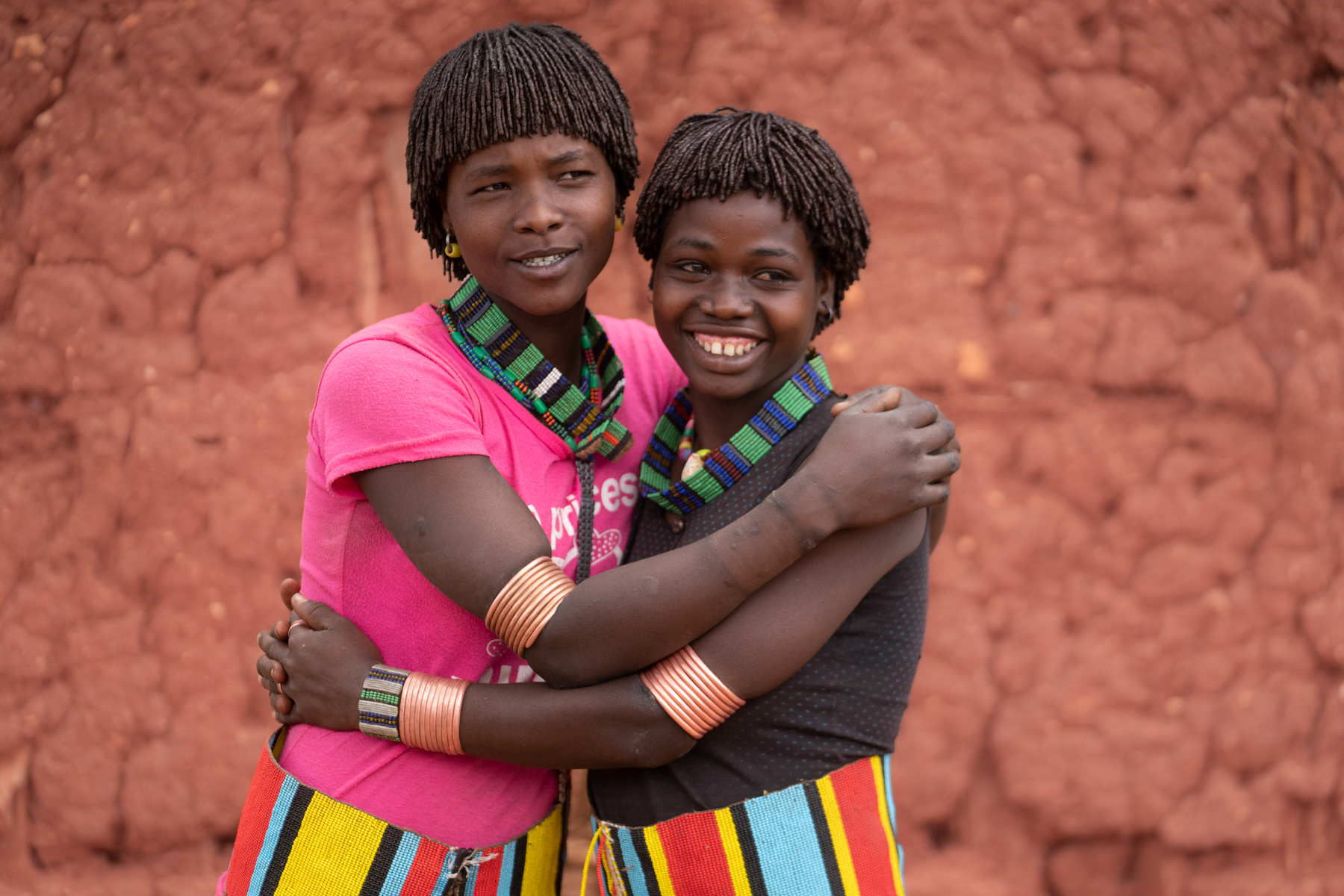
Benna best friends embrace and giggle in Alduba market (image by Inger Vandyke)

A prominent Karo family herding their livestock in the dust and storm clouds of sunrise (image by Inger Vandyke)
The 2023 Wild Images Omo Valley expedition was the most successful trip in our company’s history. Not only did we manage to see three full ceremonies (something that is more or less unheard of with tours to the region), but we were generously invited to witness and photograph some truly intimate and beautiful cultural practices that are not often seen on one trip to the Omo Valley.
The three large ceremonies we witnessed included:
– A Donga, or stick fight, in Suri culture
– Dimi initiation ceremony for young girls in Dassanech culture
– Hamer bull jump initiation ceremony for young Hamer men
The smaller cultural practices we observed included:
– Scarification, warrior decoration and a cattle camp in Suri culture
– Spontaneous dancing by a beautiful Nyangatom woman
– An unplanned meeting with a Benna wedding party of bride and bride’s maids
– Wedding preparation of young men in Arbore culture
Combine these fascinating highlights with phenomenal weather extremes, and a wonderful group of guests, and we were all left reeling. Our hearts, minds and cards were full of experiences that would linger in our memories forever.
It had been three years since Wild Images last visited the Omo Valley. Underpinning our ethos about visiting this incredible corner of Africa is to move with our most profound respect and humility through the communities of people in the Omo Valley. As such, when we arrived at many of our tour destinations, we were welcomed almost like old friends.
At the beginning of our tour, the entire Omo Valley was in the grip of a raging drought that had killed over 20,000 cows in nearby northern Kenya. During our expedition, drought brought dust storms and forced us to drive through large pits of bull dust to reach small towns. However, mid-way through the expedition, we were treated to some incredible tropical downpours and even a thunderstorm that drove so much rain towards us that we had to drive our vehicles through a flooded river that had seen its first waters in over 18 months.
What an adventure it all was!
Addis Ababa
Our group assembled in Addis, and after a day of getting over our jetlag, we enjoyed dinner with our main guide of the trip, Tesfaw, and Ethiopian friend Mikael, at a local restaurant serving some of the finest Ethiopian food in the city. While we dined, we enjoyed some traditional dancing, ranging from a ‘nouveau’ Konso performance to the more classical music played on a ‘Masinko’, or Ethiopian Violin. Joining these musicians were a group of Kunama women who enthralled us with their stunning dancing and singing. The Kunama people usually reside in the borderlands between Ethiopia and Eritrea, so their appearance on the eve of our tour was a welcomed yet unexpected cultural highlight.
Our Wild Images tours to the Omo Valley usually kick off with a morning in Addis, where we stop by a local historical coffee bar for superb Ethiopian espresso in the heart of the Italianate quarter of the city. This decades-old coffee shop serves coffee to Ethiopian commuters in a tiny store with counters covered in a patina of people traffic. The coffee is superb, a true heart-starter and a great place to join local Ethiopian people stopping for coffee on their daily commute to work.
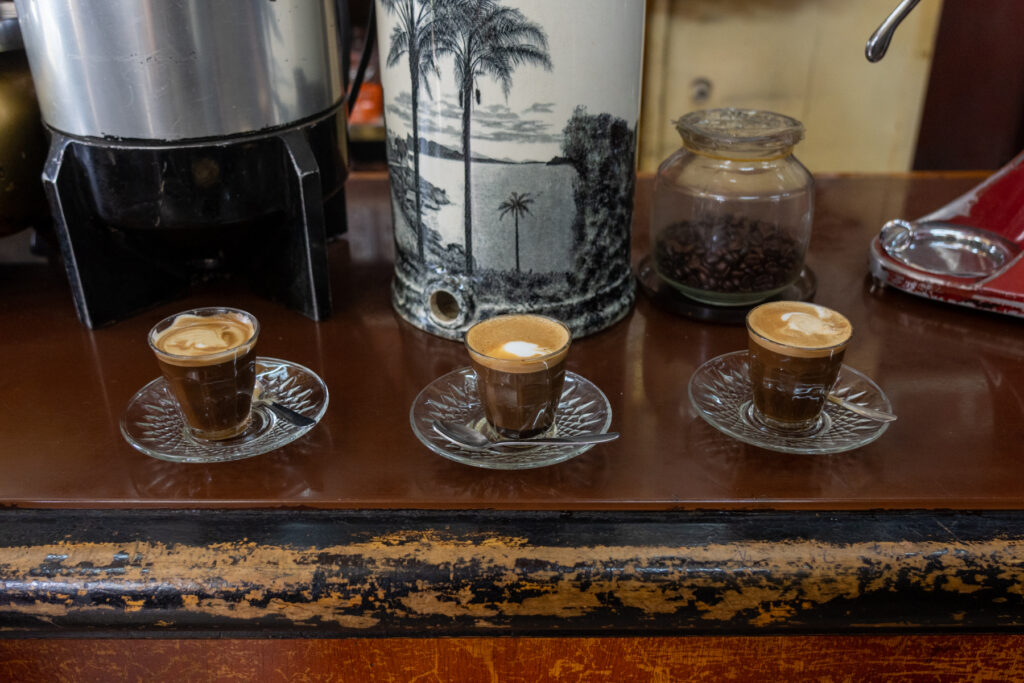
There’s nothing like a good Ethiopian espresso to get your heart started before a morning of exploration in Addis (image by Inger Vandyke)
After enjoying fabulous coffee in that historical atmosphere, we visited the Cathedral of St George, one of the largest of its kind in Addis. We were visiting during a fasting period, so a surprising number of pilgrims were visiting the cathedral along with us. After photographing some of them and the visiting Christian priests, we enjoyed a brief tour of the cathedral’s interior, including its replica Arc of the Covenant, before we left to visit a local gallery known for its superb antiques from the Horn of Africa.
Normally when our guests wish to shop in Addis, we encourage them to buy directly from the artisans, churches or local people who sell items. In Addis, we visit a renowned gallery that sells various items, including antique crucifixes, decorative calabashes, hand-carved boxes and masks, plus a stunning selection of jewellery. If nothing is suited to the tastes of our guests who wish to buy more modern items, we generally try to support a local NGO that is dealing with the debilitating issue of obstetric fistula in Ethiopia, where all proceeds of sales support a fistula hospital in the capital. For our guests this year, the antique shop was like raiding the tomb in an Indiana Jones movie. Upon entering this fantastic gallery, I quickly learned what it was like to lose my guests in shopping! They all disappeared down a labyrinth of narrow aisles and shelves until we finally all emerged, sated from our buying and ready-to-store items at our hotel in Addis, to be collected at the end of our trip.
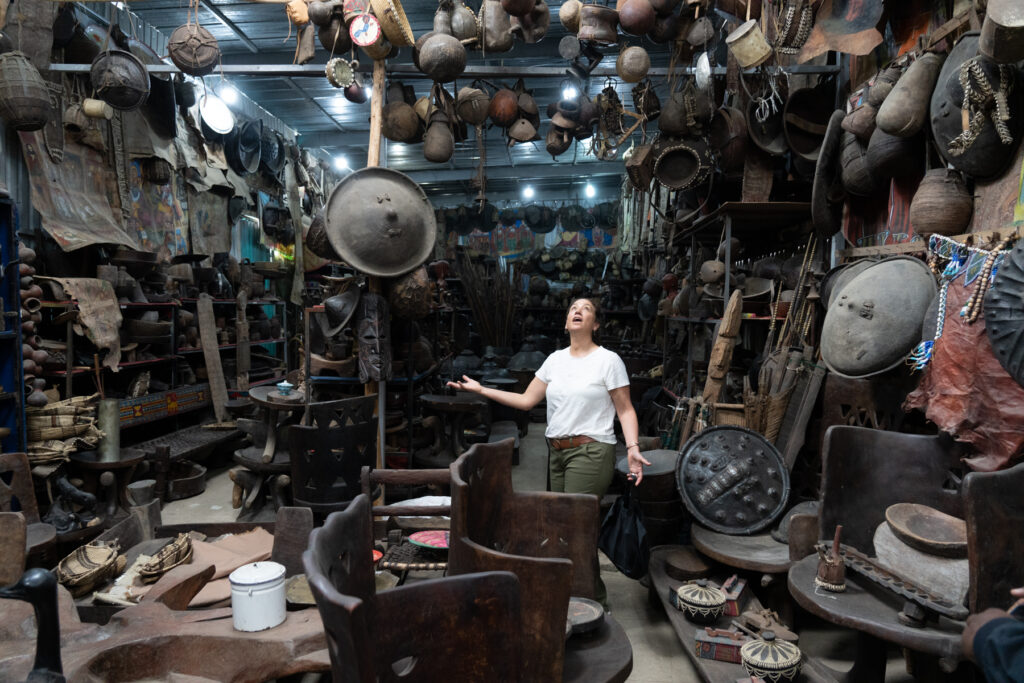
Shopping for antiques in Addis is a bit like visiting the set of an Indiana Jones movie! (image by Inger Vandyke)
We stopped for lunch at a wonderful local café before returning to our hotel to pick up our bags and head to the airport for our flight to Jimma. Arriving with enough time for a rest, we eventually met up to enjoy our first dinner in southern Ethiopia, under the stars and beside a local hotel pool. We were serenaded by the calls of a group of Hadeda Ibis returning to their night roost nearby.
We packed our vehicles before sunrise and left for the Omo Valley the following day. These early starts are always sprinkled with strange on-road encounters, and we came across herds of goats sleeping on the road and a local donkey herder moving his flock along the route. As the sun rose, we stopped to photograph some mist-laden valleys just south of Jimma. At this point, we realised it was Sunday, so many churchgoers were also out on foot to reach their early morning mass.
It was on this day that we started to see our first wildlife of the trip, including Black & White Colobus Monkeys, Olive Baboons, Vervet Monkeys and a great variety of birds.
Maji
We were travelling firmly through Maji territory now, and the ramshackle houses of the towns gave way to some pretty, hand-sculpted Tukul houses with beautifully painted motifs on the outside. The Maji people of southern Ethiopia are principally engaged in agriculture. Although they are western dressed, their homes are some of the finest examples of vernacular architecture we would see on our trip. Hence, we stopped to meet some local people while photographing their beautiful artistic homes.
By the time we reached Mizan all of us were desperate for coffee and breakfast, so we stopped by a wonderful hotel to enjoy brunch before continuing south.
Suri (Surma)
By the time we reached the Suri area, it was mid-afternoon, and sadly, we missed our first-afternoon shoot due to some local conflict over the campsite we were due to stay at. After this was resolved, we settled into our campsite for the night under the shade of a local fig tree close to the Kibish River.
Despite the fact that our photography was thwarted by a few hours on the first day, what followed in the three days we spent in Suri territory was nothing short of spectacular. Not only did we witness a traditional Donga, or stick fight, of the Suri people (I strongly suspected that this fight was being used to settle the issue over our campsite), we visited some beautiful local Suri villages, Kibish town and one of the most sublimely beautiful cattle camps I’d ever seen in the hills of these incredible people.
Young Suri men participate in a Donga, or stick fight, to settle a dispute between clans (video by Inger Vandyke)
At one point, we were asked if we would like to see what it was like to perform the trademark keloid scarification. Of course, we said yes, so we joined three pretty Suri girls in the nearby river to watch them undergo this essential decoration rite of their culture. We also watched a group of young Suri men paint their bodies like warriors, and each night we were joined by local Suri people around the campfire.
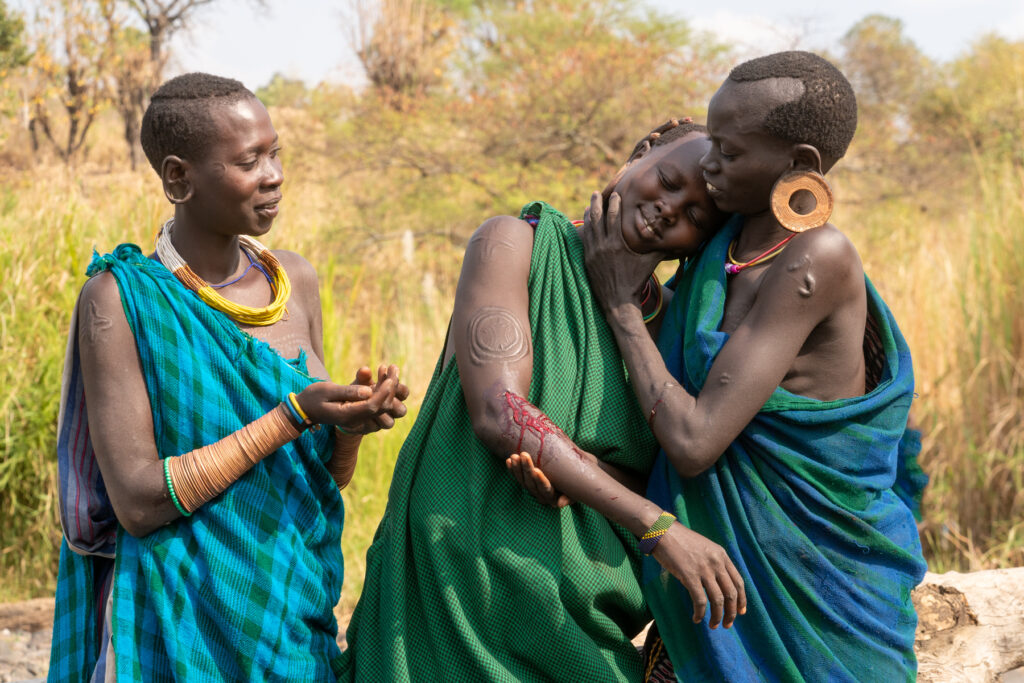
At the end of her scarification, a young Suri girl is supported by her friend and smiles with relief that its over (image by Inger Vandyke)
Our breaks in the middle of the day were often spent lying on stretcher beds outside, enjoying encounters with some of the local birds who regularly visited the shady fig tree in our camp to feed.
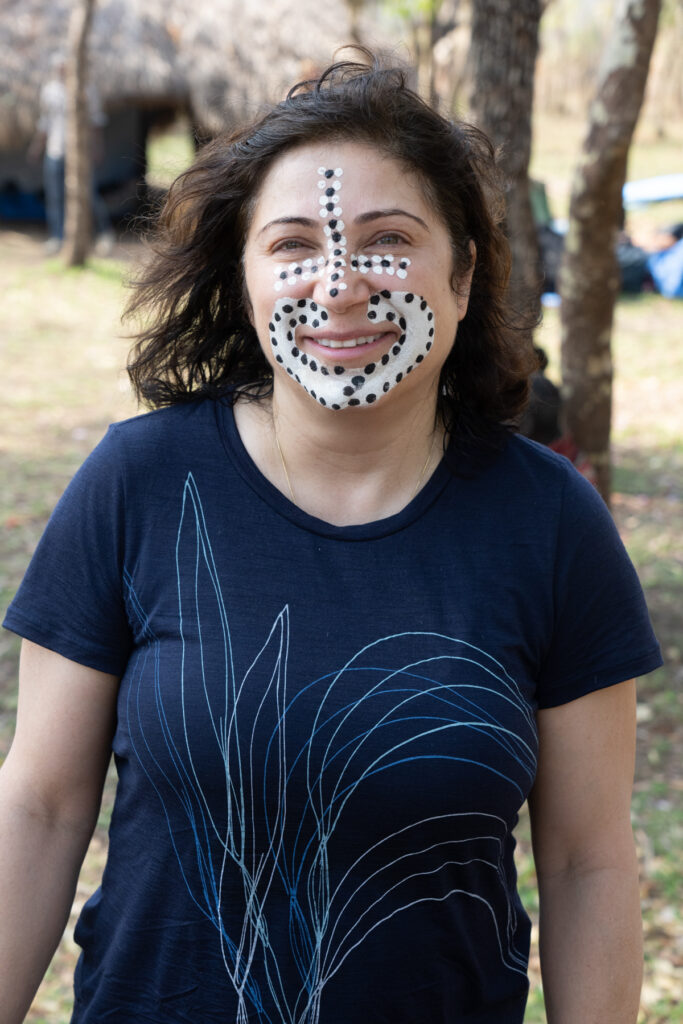
Why not get your face painted too? (image by Inger Vandyke)
Over a few days, we’d seen so much that a number of our guests joked they could go home right now and already be happy with the time they had spent in the Omo Valley!
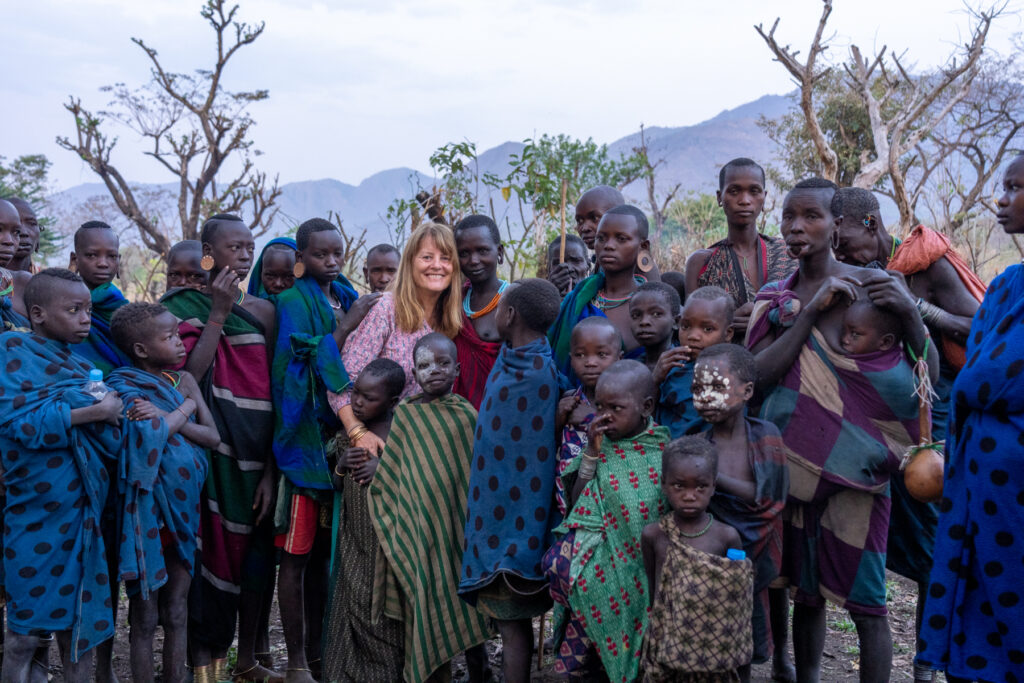
Saying farewell to the magnificent Suri people of Ethiopia is always a bittersweet moment (image by Inger Vandyke)
Dizi
We left the Kibish Hills around sunrise to traverse one of the most challenging roads of our expedition, the route out of the Kibish Hills that travels southwest towards the Ilemi Triangle. During our travels, we stopped nearby some villages of the local Dizi people who were actively involved in growing False Banana, or Enset, a wild African banana relative domesticated in the Ethiopian highlands. Curiously, this plant looks like a regular banana, but instead of bearing fruit, it is used as a starchy staple food by the people of southern Ethiopia.
Omo National Park
Continuing our journey south, we eventually reached a dusty sugar milling town, where we stopped for some cold beers and an early lunch prepared for us by our excellent camp cooks.
After lunch, we drove a gentle safari through the nearby Omo National Park. Although it was terrible light and many creatures were sheltering in the shade to escape the heat, we did see more Oribi than expected here, plus a good variety of avifauna.
Nyangatom and Toposa
When the light started to improve, we drove out to a spectacularly remote community of Nyangatom and Toposa people living in a wild corner of the Ilemi Triangle, a stretch of land that spans the countries of South Sudan, Ethiopia and Kenya.
Preserved by isolation, these stunningly beautiful villages featured beautifully thatched “Ekore” granary houses and Nyangatom homes, all constructed by local women. After the initial excitement of our arrival settled down, we went off on foot to explore these villages and meet some of their residents. It was astonishing to see such beautiful architecture here, and we felt like barely anyone had seen these places at all in the past.
From my personal experiences, they were the most stunning villages I’d seen of their type outside of the Toposa villages in South Sudan. We lingered until sunset taking photos and enjoying the company of local people before we returned to camp under the stars in this harsh, remote location. That night most of us fell asleep listening to young Nyangatom children singing. If there was a more magical way to end a day, I really couldn’t think of it.
The following day we revisited the villages on foot shortly before dawn, and we spent a remarkable few hours photographing intricately decorated Nyangatom women in their village compounds. Here we also met a Toposa man visiting his family in Ethiopia from his home in South Sudan. It was getting tough for us to leave, and just as we started towards the exit gate of one village, a local Nyangatom woman began to sing and dance a solo traditional farewell dance for us. It was so incredible it moved me to tears.
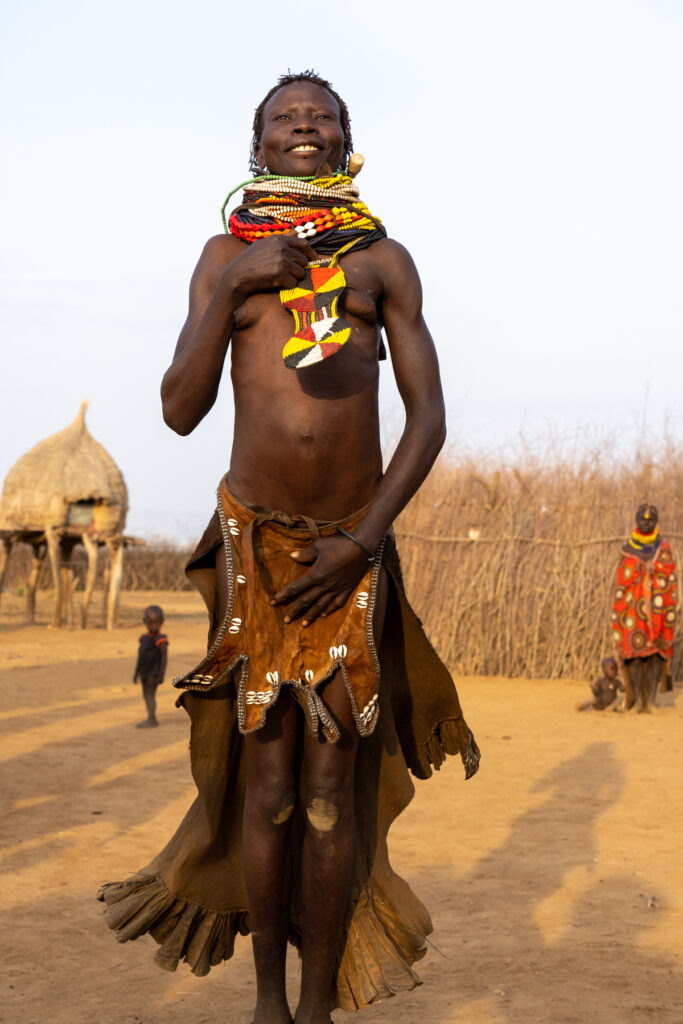
A Nyangatom woman breaks into a spontaneous dance during our visit. It was so beautiful! (image by Inger Vandyke)
Karo
We finally packed up our cars and headed towards the remote and ramshackle border town of Kangate. Kangate has always fascinated me for its incredible mix of people on the move between the three countries of the Ilemi. Although it looks like a dusty one-horse town, it is always a great place to people-watch. Situated on our way east, it is also ideal for grabbing an early morning coffee before we farewell the westernmost point of our trip.
Driving towards the Karo region of the Omo Valley, the true extent of the drought unfolded before our eyes. We left the bitumen road to take a series of dirt tracks that would lead us down to the Omo River when suddenly we found a semi-trailer bogged in deep bull dust. We got out to survey the situation. Luckily, we were in three land cruisers, so even if one of us got bogged in the same ditch, we’d recover. Thankfully it wasn’t necessary as our skilled drivers got us through this stretch of bull dust in spectacular fashion while some of us watched it all from the roadside, enthralled.
One of our drivers expertly navigates his car past a bogged truck in a spectacular bull dust pit (video by our Wild Images team)
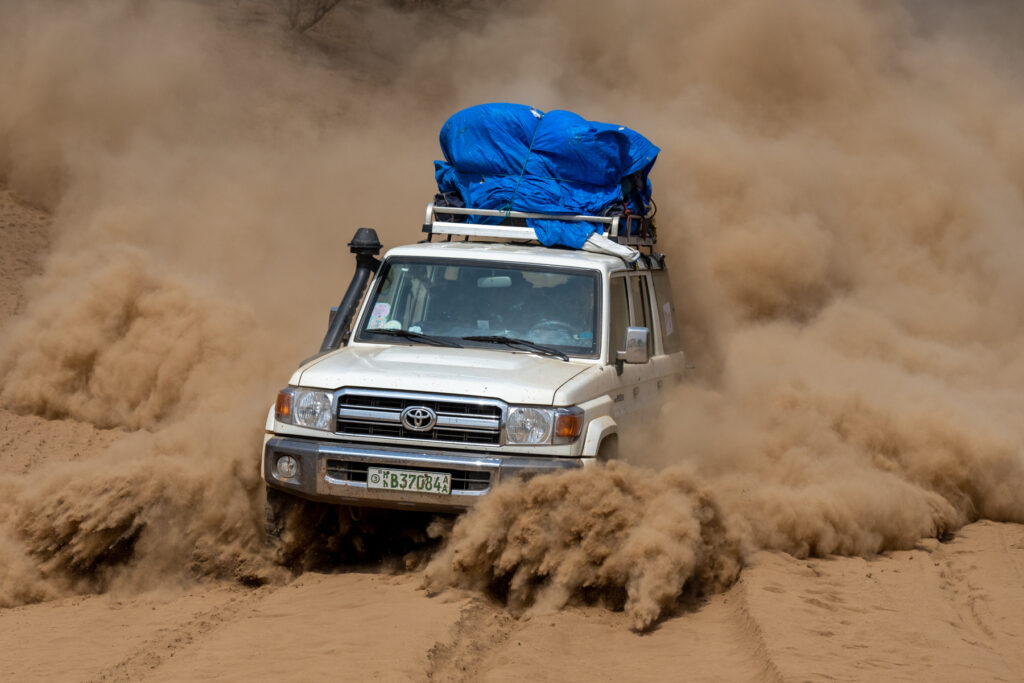
Look at that bull dust! Classic Africa on the 2023 Wild Images Omo Valley photo tour (image by Inger Vandyke)
When we arrived at our camp, we had time to rest and enjoy lunch under the trees. Meanwhile, a cheeky Black & White Colobus monkey eyed us from his lofty abode in the trees above our heads, waiting for the right moment to come and steal our lunch fruit! As we sat enjoying the fantastic views and doing a little birdwatching around the camp, a brisk breeze blew up near the river. Initially, I thought this would bring us a dust storm, but instead, the clouds opened up to dowse us in a warm rain shower. We were so happy to see it that a few of us just enjoyed the impromptu shower outside.
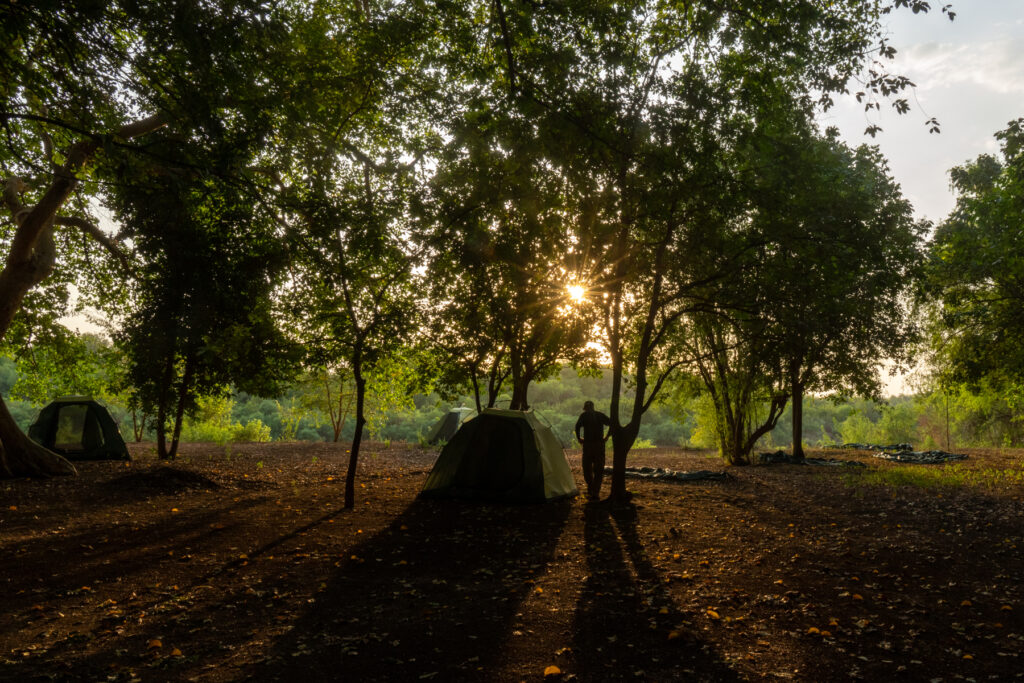
One of our group members at our fantastic campsite one late afternoon (image by Inger Vandyke)
It eventually subsided and we went off to enjoy the wonderful late afternoon light taking photos in a nearby village of Karo people. Normally at the time of year we visit, there is a small amount of vegetation growing around the village houses. This year, however, all of it was gone – a strong testimonial to the severe lack of rains in the Omo Valley. Instead of a verdant landscape, the parched earth was barren and dusty. Although these conditions allowed for some wonderful photography of the local Karo headmen, I couldn’t help but hope that these people would get more rain when their entire community desperately needed it.
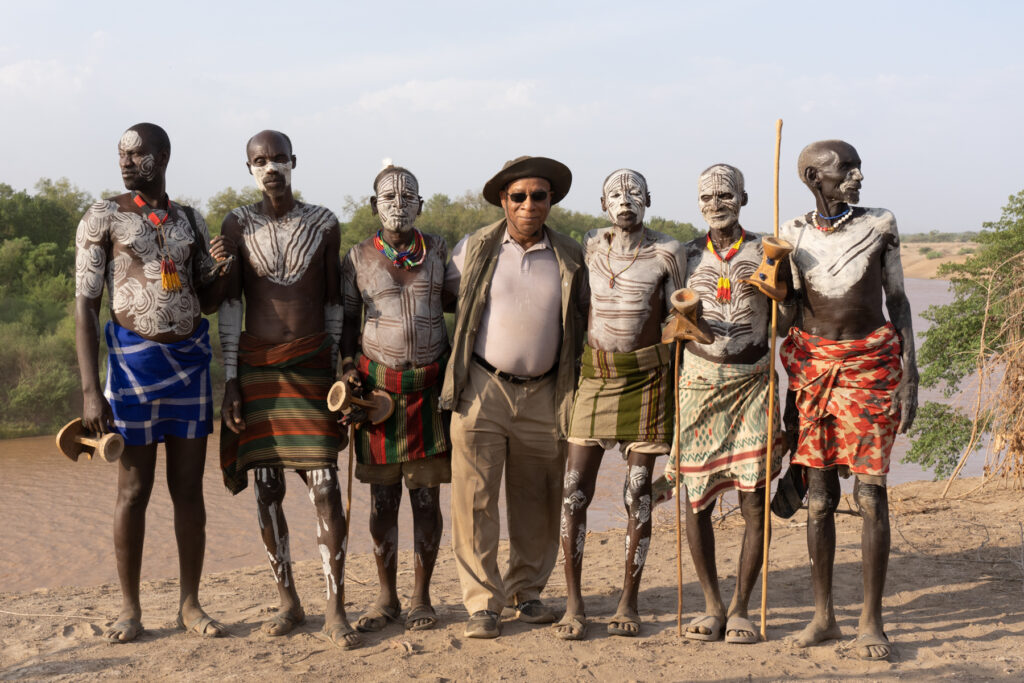
Hanging out with the Karo head men of Dus (image by Inger Vandyke)
That night we dined under the stars next to the Omo River. One of the local headmen gifted us one of his goats which was expertly cooked for us over an open fire next to the river. Sitting and watching ‘African TV’ is always a highlight of our tours and this evening’s shows didn’t disappoint as we occasionally got up to spotlight for crocodiles hunting the shoreline at the edge of the steep river banks below us.
During the night, we were serenaded by a Wood Owl, Olive Baboons and the piercing cries of Senegal Thick-knees. Of all the places we camp on our trip, this site has always been a favourite of mine. The diversity of birds and wildlife here is always surprising. On this trip, we even heard a distant hippo calling from further up the river. It’s possible to watch hunting African Fish Eagles here, brightly coloured Gonoleks and Barbets feeding on figs and also be visited by monkeys and baboons. From a more human perspective, you can often see Karo shepherds returning to the village with their herds after taking them to drink, the tinkle of goat and sheep bells intercepting the sounds of the bush. It is just a magical place to stay.
The following day we arrived at the local Karo village before sunrise to visit and photograph a family herding their livestock at dawn. The storm clouds of the previous day morphed into one of the most incredible sunrises, and we were blessed to photograph this incredible situation during the blush of a new day.
A prominent local Karo family herds their sheep and goats during the dust and clouds of a dramatic sunrise (video by our Wild Images team)
After the herding had finished, we spent a little time doing portrait photography of some local Karo people before we were kindly invited to the home of one of the local headmen for tea. When we arrived, we were honoured to find him placing his finest animal skins on the ground for us to be seated. Once inside, we enjoyed some excellent sweet tea that was served to us in ceremonial calabashes. It was delicious, and the warm, graciousness of our hosts moved all of us to tears. What an amazing time to while the time away while we waited for our camp crew to pack up and come and collect us. We finally saw them rounding the corner to the village so we said our sad goodbyes to our friendly Karo hosts and then left for Turmi.
Hamer
That afternoon we visited a reasonably remote series of tiny Hamer communities. We were blessed to wander around family compounds, chatting with people and taking casual photos. It was a spectacular afternoon, weatherwise, with storm clouds lit by a setting sun that forced rainbows into the sky. It was our first taste of Hamer culture and its decorative beauty. At one point, a local family invited us in for coffee, and the more agile members of our group graciously accepted their invitation. When I mentioned agile, it is because the entranceways to Hamer homes usually require a bit of contortionist work by larger western guests to go into them. Some of us were pretty thankful for our at-home yoga classes at that moment! Still, once inside, it was wonderful to feel the warmth and homeliness of this tukul home with our host family cooking strong coffee on an open fire at its heart.
By the time we had to leave, the sun was setting, and the light was becoming too difficult for photographs. In the coming days, we enjoyed a few more meetings with local Hamer people, including visiting the weekly market in Turmi, where many Hamer people gather to buy and sell their wares, a remote agricultural farm with a stunning Hamer lady storing firewood in a tall desert rose, a bull jumping ceremony and finally, we watched local Hamer people trying to navigate their way across the swollen floodwaters of the Lesser Keskede river, coaxing reluctant livestock to get through the sudden flood.
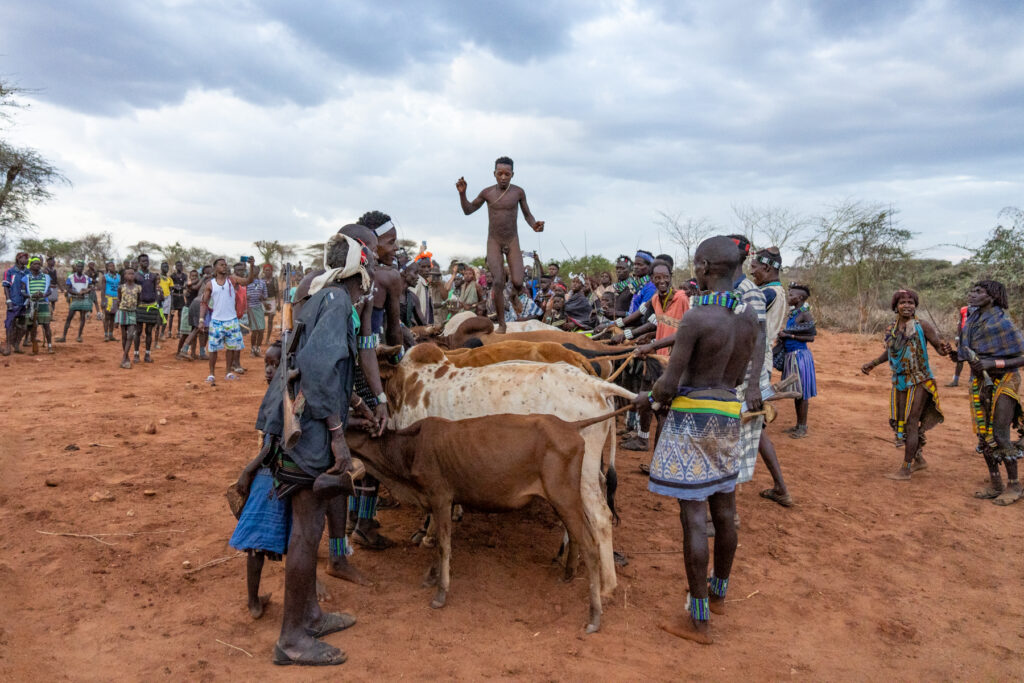
An essential rite of passage for young boys in Hamer culture, the bull jumping ceremony is vital to young Hamer boys becoming men (image by Inger Vandyke)
It was all incredibly fascinating, and the variety of things we witnessed with the Hamer people on this tour was exceptional.
Dassanech
We left before sunrise one morning to drive southwards, towards the Ethiopian border of northern Kenya. Stopping short of the border by around 35 kilometres, we visited a temporary mobile camp of the Dassanech people to witness a celebration of Dimi, or the initiation of young Dassanech girls. The drive down to Kenya has always been enthralling for me. Here in the wildest bush and desert landscapes of southern Ethiopia, I’ve seen all sorts of wildlife wandering the road in the dark. On this trip, we saw a Scrub Hare, and several Slender-tailed Nightjars on the road. At one point, I even saw the glaring orange eyeshine of a Senegal Galago.
By the time we reached the Dassanech village, it was still dark, and our host families were waking up. We all enjoyed a back-of-the-car coffee and snack to wake ourselves up and prepare for the sunrise. Then it all happened. After a mesmerising dawn, several nomadic Dassanech men appeared from their homes and began covering their skin with yellow ochre in preparation for the ceremony. They kindly allowed us to watch and photograph them, preparing for this important rite of passage amongst Dassanech women. The final act of their preparation was the donning of wild animal skins; for the men, these translated into skins of leopard, serval or cheetah. For the women, they adorned themselves with the stunning pelts of black and white Colobus monkeys. Finally, the group of ceremonial dancers visited the homes of young girls, dancing and singing outside each, to herald the start of their journey into womanhood. It was all mesmerising, beautiful and fascinating to see.
Dassanech people in southern Ethiopia sing and dance to celebrate Dimi, the initiation ceremony of young Dassanech girls (video by Inger Vandyke)
After the main ceremony had concluded, we were allowed to take some beautiful photos of the adorned Dassanech in attendance. We then wandered around a local, more settled community of Dassanech people to take photos of their daily life. Coffee finally called us again, so we left and went into town. We enjoyed a local coffee in a tiny riverside restaurant with beautiful riverine birds like Malachite Kingfisher and Black-headed Gonolek. As we sat admiring the river, we shared laughs with some young Dassanech kids who paddled their hand-carved dugout canoes against the current to greet us and say hello. We all admired their strength and persistence to reach us against the strength of the river current!
After we left Omorate to drive back to Turmi, our vehicle convoy became engulfed in quite a violent dust storm. The heat and wind shrouded the desert landscape, decreasing our visibility to the point where we had to slow down. Just as I watched the entire scene develop in front of us, I wondered if we might see some people and at that moment, I saw a group of Dassanech shepherds trying to get their herds back to their village. I told our cars to stop, and as we all braved the high winds and dust, a beautiful young Dassanech woman came walking towards us out of this ghost-like environment. It was incredible to see such a beautiful, strong woman walk over to greet us, closely followed by her family. As we stood around talking to them and taking photos, the storm quickly subsided, and we continued our homeward journeys.
Finally, we returned to Turmi, where we had lunch and a quick turnaround before we drove out to a very remote region to see our entire third ceremony of the tour. To be honest, we were extraordinarily lucky to see three large ceremonies like this in the Omo Valley. Even with our company knowledge and experience, the most we’ve ever seen on any tour is two.
After a bumpy drive over stunning hilly terrain, we arrived at the ceremony location and joyously discovered that only two other tourists were present at this event. Between us, we joined a throng of over 200 Hamer people in the end for an afternoon of singing, festivities, the ceremonial face painting of the assistant Mazas, the curious begging women who wanted to be whipped in order to show the strength of devotion to the young boy about to be initiated, private coffee ceremonies and the final act of the initiate boy of running over the backs of tethered bulls to prove he is ready for manhood. While a lot of the Hamer people attending this ceremony were wearing a mix of western and traditional clothes, we did manage to meet a couple of highly decorated Hamer men, both of whom had recently killed large animals, so they were celebrated with spectacular decorations including newly made up Shoshole (or skull caps) adorned with feathers and jewellery that also featured many feathers. We found out in the end that one had recently killed a buffalo, the other a hyena. Sadly the main event happened when it was almost too dark to photograph it. Still, we enjoyed this complex ceremony a lot as its numerous different stages not only fascinated us but offered some interesting photographic perspectives on Hamer culture.
Abore (Erbore, Uhlde)
The following morning was a relaxing, sleep-in day. Especially after seeing two huge ceremonies of the Omo in one day, we all enjoyed a late start with a long breakfast and coffee.
That afternoon we packed up our vehicles and embarked on the long drive over the Buska mountains to reach Lake Chew Bahir, home of the Arbore people. As the tour leader of this trip, I was surprised to see new roads being pushed through this area and once adventurous stretches now heavily graded. Initially, I had hoped to show my guests a good desert rose tree in bloom. When I found one, I was dismayed to find a few of them wanted to stay in the car; that was until I mentioned that a stunning Hamer lady was using the upper branches of this tree to store her firewood and keep it away from termites. We asked if she minded us visiting. When she kindly accepted, what followed was a stunning exploration of agricultural life in the Hamer people, including this beautiful woman in her temporary sculpted agriculture shelter, which was almost as beautiful as she was.
We eventually left and continued our drive through the mountains. As we reached the eastern side of them, the vast expanses of Lake Chew Bahir unfolded before our eyes. Aside from the sighting of our first Von Der Decken’s Hornbills in the mountains, the intensity of our wildlife sightings increased as we drove around the edge of the lake, which is a nature reserve in itself. It was during this last stretch before reaching the Arbore villages that we saw a good variety of raptors, including our first two White-headed Vultures and good numbers of Marabou Storks. With the latter, we had an almost uniquely Omo Valley challenge – at one point, I had to get out of the car to clear a ‘stork jam’ of Marabous, who decided the road was an excellent place to have a siesta. Not wanting to frighten them with an oncoming speeding car, I got out and ran to get them off the road for their safety and a few of us watched as these gigantic birds took flight right before our eyes.
Tour leader Inger gets out of the car and clears the ‘Stork Jam’ of Marabou Storks on the eastern side of Ethiopia’s Buska Mountains (video by Wild Images guest)
We finally reached some of Lake Chew Bahir’s spectacular Arbore villages under the shelter of storm clouds. The rain threatened, but it never came. We spent the remaining daylight hours wandering around Arbore villages, meeting old friends and friendly locals, taking photos and exploring Arbore ways of life. While I had initially hoped to camp near the home of a friend of mine, we were directed to pitch our tents in a local fenced compound which was quite good in the end as a few of our group were kept awake by the calls of a howling Spotted Hyena.
Before sunrise the following day, our alarm bell turned out to be a local Arbore herder bringing his cows in for the day. Tragically Lake Chew Bahir sits in a rain shadow, so this year, I struggled to watch these communities deal with a terrible drought. We saw quite a number of unwell animals, and the circling Ruppell’s Vultures did nothing to appease the looming crisis of these villages.
Arbore people have unbelievable friendliness and beauty surrounding them. For someone who knows these people well, it was heartbreaking to watch them go through these struggles, and I hope our visit at least contributed to easing their issues related to the ongoing drought.
That morning we watched a beautiful group of young Arbore men prepare for a wedding celebration. This involved a small group of men delicately painting their faces with white chalk dots on a red and yellow ochre background. This sublimely beautiful practice was wonderful to photograph and underpinned the stunning elegance of these people who live in one of the harshest environments of southern Ethiopia.
Before we left our newfound friends, I met with village elders to see if we could hatch a plan to help these communities, so discussions are now in progress with Wild Images to see if there is a way we can deliver items of the highest priority to these people.
Turmi Street Photography
Our drive back through the Buskas to Turmi could have been more eventful regarding wildlife, but as we drove further towards Turmi we began to see quite a few Hamer people on foot heading to the local market in town. After checking back into our hotel, we had a light lunch and went in to check out the weekly Turmi tribal market, which is always a fantastic place to enjoy some street photography. We wandered around enjoying the crowds with all of Turmi’s charismatic dirt streets and colourful walls, taking photos and watching life transpire in this frontier-like town filled with many different people of mostly Hamer cultures, including some Benna and Karo. When the pace of the market got a bit hectic, we all retreated to a local bar for a cold beer to get some rest from the heat. As we sat there, a massive thunderstorm broke out and doused Turmi in some much-needed torrential rain. A few of us sheltered a little hotel dog frightened by the lightning and thunder. The rain continued as we ordered our second round of beers.
Finally, a gap in the weather allowed us to jump in the cars and drive back to the lodge, which we thought would be easy until we realised the dry riverbed of the Lesser Keskede river, which separated us from the lodge, was now heaving with a sudden desert flood. We stopped the cars to watch it for a while. Often these flash floods in the desert die down as fast as they rise. We had a little time to wait, and I was happy we did in the end as our group got out of the car to watch this wild contrast in weather from the dust storm of just two days ago.
We weren’t the only people trying to get home. Many local Hamer villagers were trying to get through the sudden flood to walk back as well. We watched with amusement as some Hamer people tried to coax their livestock across the shallowing waters of the flooded river. A short time later, I walked across it to check the depth before giving the cars the OK to drive across it. What an adventure! We reached the lodge in time for us all to dry out, and as I sat writing my notes about the day on the balcony of my room, I was watching the birdlife come alive on the edge of the Greater Keskede, where our lodge was located.
After wading across to check the water depth, tour leader Inger videos her vehicles crossing the Lesser Keskede river, which was awash with a flash flood (video by Inger Vandyke)
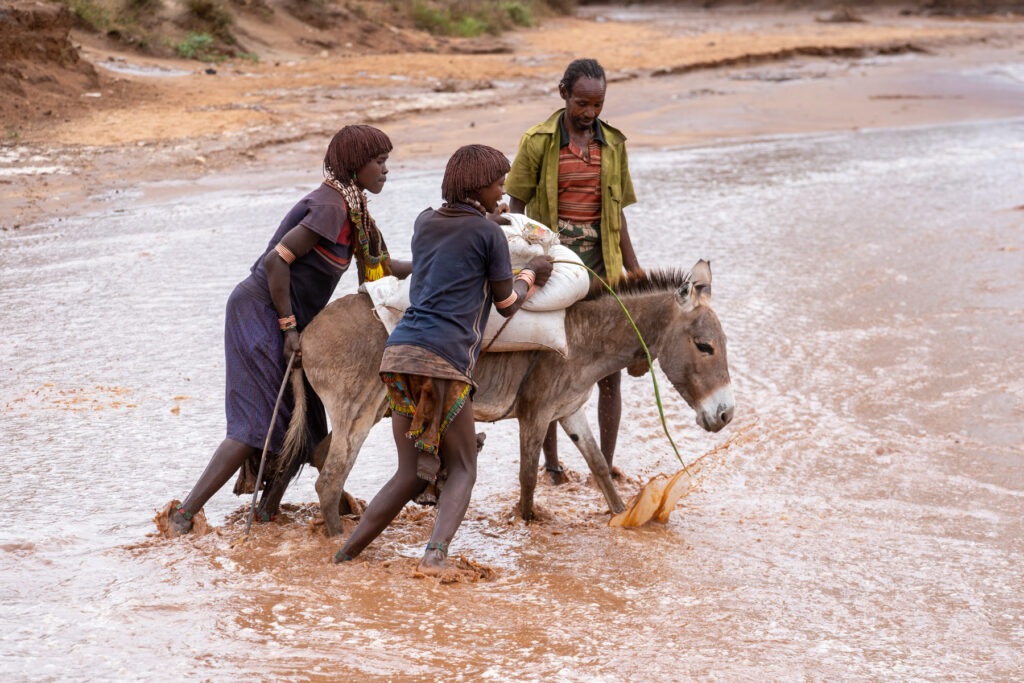
A group of Hamer people coaxing a very reluctant donkey across the flooded Keskede, trying to return home from the weekly market (image by Inger Vandyke)
Benna
The grey stormy skies and rains continued to feature in our tour until the end. None of us minded. The people of the Omo desperately needed rain, and the overcast skies made for more dramatic photography in some ways and for wonderful people photography in others.
We left Turmi to drive north to Jinka under more cloudy and rainy skies. Soon we were travelling through the region of the Benna people, the tenth culture we would meet on our tour. Typically semi-nomadic agro-pastoralists, Benna people are very closely related to Hamer in terms of culture, language and decoration. Despite this, it takes a trained eye to tell them apart, and thankfully we met a group of lovely young Benna people gathered on the side of the road whom we enjoyed meeting en route to Alduba. It was here that we could stop and take some photographs while I explained how the Benna differ in culture from the Hamer. We met a fantastic young Benna guy who kindly allowed us to take his photo and I think he wondered what the fuss was all about in the end.
Alduba Market
Of all the weekly markets that occur in the Omo Valley, the bustling market of Alduba is one of the largest. It acts as an epi-centre of cultural people that are mostly Benna or Hamer Besheda, another minority cultural group that stems from the larger group of Hamer people. In Alduba we were surprised to encounter a group of beautiful young Benna women including a bride and her bride’s maids, walking together to what we thought may be a bull jumping ceremony later that day. The bride of this group was so incredibly beautiful we asked if we might be able to photograph her and after a little consideration she obliged. What an amazing looking girl! The guy who runs the bulls and receives her was going to be a very lucy man!
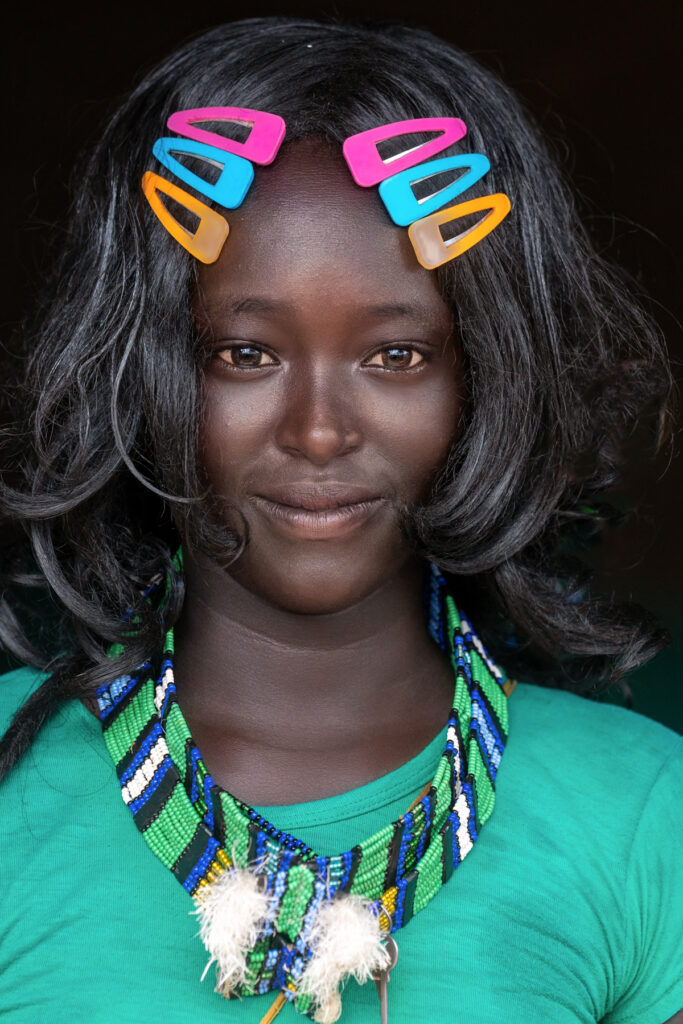
And he will run the backs of bulls to impress his beautiful Benna bride…. (image by Inger Vandyke)
We stopped and spent a couple of hours wandering around the market, meeting and photographing local Benna and Besheda people before we returned to our cars to drive north towards Jinka. Rain loomed again on the horizon, so while it was tempting to stop and photograph more people plus some lovely brightly painted tukul houses, we continued to Jinka where we stopped for the day and enjoyed a late lunch, then dinner at our lodge.
Mursi
The following morning we left before sunrise to drive through Mago National Park in order to reach two of the open villages of Mursi people. The night drives here are also interesting in terms of wildlife. This drive allowed us to get a brief glimpse of a Spotted Genet and a Greyish Eagle Owl who had decided to prey on some road kill. We reached the Mursi villages shortly before sunrise.
These spectacular people are culturally related to the Suri people we met at the start of the trip. Many of their customs and language are the same. We arrived to find a small group of Mursi painting each other’s faces and also painting some hand-sculpted items like lip plates and tiny clay toys in order for us to buy later.
It’s always magical to be in a Mursi village at sunrise. Spending time with these dramatically decorated people is never disappointing. They are possibly the most elaborately and heavily decorated people we saw on our tour, and this morning didn’t disappoint as we met and photographed some of these fascinating people both in their village and in a nearby field.
After stopping to buy some lip plates and other items we drove out of Mago in time to have a late breakfast at the lodge.
Benna Stilt Boys
We packed up and left, stopping to photograph a curious group of young Benna boys who walk the road on stilts hoping to make some extra cash from passing photographers. Although the legend behind why these boys walk on stilts is a little dubious, stopping to photograph them is always such a fun experience, and this time it proved no different. We arrived to watch a father guide his young son to walk on stilts before we met up with the main group of boys for many laughs as we tried to photograph them from different angles.
Tsemay
Our drive today was the penultimate day of the tour, and after we left the Benna boys, we drove through the headwaters of the Woyto River, through a number of Tsemay homesteads. The Tsemay of the Omo differs from other cultures through their preferred decoration of tattooing rather than scarification. Their most notable feature on a drive, however, is the women wearing brightly coloured, striped skirts, along with traditional ‘shirts’ fashioned out of goat skins and cowrie shells.
We still had quite a drive ahead of us, so sadly we couldn’t stop to meet any Tsemay this time. We did see the Woyto swollen with flood waters which was beautiful to see as these waters will eventually flow into Lake Chew Bahir, and we hoped they would bring some much-needed relief to the Arbore people living closer to the lake.
Konso
As we skirted around the eastern edge of Lake Chew Bahir we passed the Arbore area before heading uphill to a lookout where we got out and indulged ourselves with our last view of the Omo Valley.Shortly after we were travelling through the spectacular, World Heritage listed terraced fields of Ethiopia’s Konso people. This ancient, fascinating culture is one of very few in Africa who practice agriculture in layered terraces so before we stopped to explore one of their villages we visited a wonderful restaurant to enjoy lunch under a gigantic fig tree.After lunch we drove down to a nearby Konso village which we explored on foot. Large dry stone walls surround almost all Konso villages to help the occupants defend their village from foes. Once you are inside the homes of the Konso people lie along a labyrinth of pathways, and the entrance to the main family complexes is adorned by hardwood sculpted gates.
At the centre of each Konso village is a square and a meeting place mainly used by men to make decisions on behalf of their communities. A totem pole will tell the age of the village, and inside Konso burial grounds, you may find a series of hand-carved Waka, or totem poles, carved to commemorate the deceased people buried beneath them.
As we wandered around various Konso family compounds all of us stopped to watch some local Konso elders playing Mancala,an ancient game that dates back past the 3rd century that is among the oldest known games to still be widely played today.
A group of elderly Konso men playing Mancala in their community (video by Inger Vandyke)
Culturally different from the other people of the Omo, the Konso people were wonderful to meet, and as we returned to our cars some of us bought some tiny balsa wood toys that local Konso children had made by hand to sell as souvenirs.
Gamo
We still had more driving to do before the day ended, so we left Konso with enough time to drive to Arba Minch.
After we left Konso we entered the realm of the region’s Gamo people, who are primarily engaged in agriculture around the regions of two gigantic lakes, Chamo and Abaya.
As we reached Arba Minch, fields gave way to the small but mysterious Nechisar National Park on Lake Chamo.We arrived at our outstanding hotel with spectacular views over these lakes in time to enjoy a farewell dinner with our team under the stars.
The following morning was our last morning of the tour. Since we had a few Omo Valley veterans on our trip, they decided to enjoy a sleep-in at the hotel while the rest of the Omo newbies joined me on a lake cruise at sunrise to visit the local fishermen of the Gamo people.
This cruise is always a lovely quiet way to end the trip as it explores tiny fishing communities, Gamo fishermen paddling their raft-like boats out onto the lake to fish, and we always see some wonderful wildlife here, including a wide variety of water birds, hippos, Nile Crocodiles and even Nile Monitors. This cruise ticked all those boxes and featured close encounters with crocodiles and the monitor. We also enjoyed watching both Goliath Herons and Hamerkop collecting nesting material on one of the islands. We swung by a nesting pair of African Fish Eagles, whose haunting cries heralded the end of the tour.
By the time we finished the cruise, we had just enough time to return to the hotel for a lovely lunch under shady trees looking out at the tremendous view.
Just as we left, a group of Dorze musicians began performing on the front steps of the hotel. What an incredible way to end our tour before we flew to Addis! None of us ever wanted the tour to end!

What a fantastic group! Our 2023 Omo Valley photographers at the incredible ceremony of Dimi (image by Inger Vandyke)




























































































































